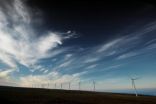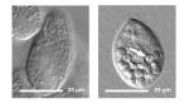(Press-News.org) RICHLAND, Wash. – Meteorological equipment typically used to monitor storms could help power grid operators know when to expect winds that will send turbine blades spinning, as well as help them avoid the sudden stress that spinning turbines could put on the electrical grid.
"We know that the wind will blow, but the real challenge is to know when and how much," said atmospheric scientist Larry Berg. "This project takes an interesting approach –adapting an established technology for a new use – to find a reliable way to measure winds and improve wind power forecasts."
Berg and Rob Newsom, both researchers at the Department of Energy's Pacific Northwest National Laboratory, are using a variety of meteorological equipment to measure winds high up into the air – about 350 feet, the average height of turbine hubs – and get a better reading on how winds behave up there.
Wind measurements are typically made much lower – at about 30 feet high – for weather monitoring purposes. Wind power companies do measure winds higher up, but that information is usually kept proprietary. PNNL's findings will be available to all online.
The study's findings could also provide more accurate wind predictions because of its field location – a working wind farm. The equipment is being erected on and near a radio tower near the 300-megawatt Stateline Wind Energy Center, a wind power project that runs along the eastern Washington-Oregon border. Any wind power company could use the study's findings to improve how sites are chosen for wind farms and how those farms are operated.
The equipment started collecting measurements in November. Berg and Newsom will continue gathering measurements for about nine months, or through this summer. The period will allow the researchers to draw a more complete and accurate picture of how wind behaves at turbine height. The period represents the windiest months for the area.
"The goal here is to help everyone – not just one group – better understand wind's behavior and ultimately improve our use of it as a renewable power source," Newsom said.
Cool tools
But first researchers need to document wind behavior. To do that, they're employing a handful of sophisticated meteorological tools.
One key instrument is the National Weather Service's NEXRAD Doppler radar weather station in Pendleton, Ore., about 19 miles south of Stateline. The station emits short pulses of radio waves that bounce back when they strike water droplets and other particles in the air. A national network of these stations is routinely used by television meteorologists to show clouds and precipitation in familiar, colorful digital maps. For this study, computers will analyze the returned signals to determine how the wind varies in the area around the radar, including the wind farm.
The team is also installing equipment specifically designed to measure wind speed and direction: a radar wind profiler. Like NEXRAD, the profiler sends out radio waves that are bounced back when it hits variations in moisture or temperature. But while NEXRAD scans the entire sky with its one rotating radar beam, the profiler sends three radar beams up into the sky. The profiler being used is part of the DOE's Atmospheric Radiation Measurement Climate Research Facility.
Another tool they're using is Doppler sodar, which uses sound instead of radio waves. A regular sequence of high-pitched beeps is sent into the sky and, like radar, will be reflected from variations in moisture and temperature. That information will help researchers measure winds that are at lower heights in the sky than the profiler can measure.
Finally, the researchers will install ultrasonic anemometers on the radio tower. The anemometer holds six tiny microphones, and measures the time it takes for sound pulses to travel from one microphone to another. Beyond measuring speed, the anemometer also helps determine wind direction. Combined, all this equipment will help researchers gain a more comprehensive understanding of how wind behaves at the turbine level of a working wind farm.
Improving renewable energy
Data collected during this study will be used to evaluate the performance of computer models of the atmosphere near the operating wind farm. These computer models are routinely used to provide weather forecasts of wind conditions hours and even days into the future. This information can help wind farms operate more efficiently and lets them better integrate the power they produce into the electric grid. These models are known to have relatively large errors in forecasting the severity and times of strong winds, including gusts during thunderstorms as fronts pass through an area. Even relatively small errors in wind speed predictions can lead to large errors in the predicted power outputs of wind farms.
When that happens, grid operators have to accommodate the influx of power, often by diverting or turning off other power sources. In the Pacific Northwest, that can mean spilling river water over hydroelectric dams instead of sending the water through the dams' power-producing turbines. Sometimes those diversions are needed on a moment's notice, when the grid becomes overwhelmed by unexpected windy weather. If such gusts could be reliably predicted ahead of time, power operators could make adequate plans beforehand. And when the wind stops blowing unexpectedly, the grid can experience a quick need for power.
Wind power companies could also use improved predictions to more wisely choose their wind farm sites. These companies invest heavily in understanding the wind characteristics of their sites before breaking ground, but forecasting turbine-level winds is still an evolving field.
As a result, two industrial partners are collaborating with Newsom and Berg on their research. 3TIER of Seattle, Wash., and WindLogics of St. Paul, Minn., both help wind power developers identify and evaluate potential locations for wind farms. They're serving as consultants and have provided input on what kind of data would be most helpful when examining wind sites.
If the NEXRAD wind data is verified by the data collected through the other meteorological equipment, the next step in this research would be to plug the NEXRAD data into a working weather model. The model could then be used to better predict future wind behavior. Using the data in a weather model is outside the scope of Berg and Newsom's current research, but they hope to be able to do so in the future.
Field work for the study began this month and will continue for about nine months. This study is funded by the DOE's Office of Energy Efficiency and Renewable Energy's Wind and Water Power Program and the Office of Science Atmospheric Radiation Measurement Facility.
INFORMATION:
Pacific Northwest National Laboratory is a Department of Energy Office of Science national laboratory where interdisciplinary teams advance science and technology and deliver solutions to America's most intractable problems in energy, the environment and national security. PNNL employs 4,700 staff, has an annual budget of nearly $1.1 billion, and has been managed by Ohio-based Battelle since the lab's inception in 1965. Follow PNNL on Facebook, LinkedIn and Twitter.
Outsmarting the wind
Study gathers comprehensive wind info to improve renewable energy
2010-12-21
ELSE PRESS RELEASES FROM THIS DATE:
CCNY-led interdisciplinary team recreates colonial hydrology
2010-12-21
Hydrologists may have a new way to study historical water conditions. By synthesizing present-day data with historical records they may be able to recreate broad hydrologic trends on a regional basis for periods from which scant data is available.
Lack of reliable historical data can impede hydrologists' understanding of the current state of waterways and their ability to make predictions about the future. That was the case for the rivers of the northeastern United States between 1600 and 1800, a period that runs from just before the first European settlers arrived ...
What makes a face look alive? Study says it's in the eyes
2010-12-21
The face of a doll is clearly not human; the face of a human clearly is. Telling the difference allows us to pay attention to faces that belong to living things, which are capable of interacting with us. But where is the line at which a face appears to be alive? A new study published in Psychological Science, a journal of the Association for Psychological Science, finds that a face has to be quite similar to a human face in order to appear alive, and that the cues are mainly in the eyes.
Several movies have tried and failed to generate lifelike animations of humans. ...
Globalization burdens future generations with biological invasions
2010-12-21
A new study on biological invasions based on extensive data of alien species from 10 taxonomic groups and 28 European countries has shown that patterns of established alien species richness are more related to historical levels of socio-economic drivers than to contemporary ones. An international group of 16 researchers reported the new finding this week in the Proceedings of the National Academy of Sciences of the United States of America (PNAS). The publication resulted from the three-year project DAISIE (Delivering Alien Invasive Inventory for Europe, www.europe-aliens.org), ...
New report finds Cambodia's HIV/AIDS fight at critical crossroads in funding, prevention
2010-12-21
Phnom Penh, Cambodia (21 December, 2010) – Despite Cambodia's remarkable history in driving down HIV infections, a report released today on the future of AIDS in the country argues that future success is not guaranteed and the government needs to focus increasingly on wise prevention tactics and assume more of the financing of its AIDS program.
The report, called The Long-Run Costs and Financing of HIV/AIDS in Cambodia, written by Cambodian experts working closely with staff of the Results for Development Institute (R4D), based in Washington, D.C., finds that Cambodia, ...
How often do giant black holes become hyperactive?
2010-12-21
A new study from NASA's Chandra X-ray Observatory tells scientists how often the biggest black holes have been active over the last few billion years. This discovery clarifies how supermassive black holes grow and could have implications for how the giant black hole at the center of the Milky Way will behave in the future.
Most galaxies, including our own, are thought to contain supermassive black holes at their centers, with masses ranging from millions to billions of times the mass of the Sun. For reasons not entirely understood, astronomers have found that these ...
New study upends thinking about how liver disease develops
2010-12-21
In the latest of a series of related papers, researchers at the University of California, San Diego School of Medicine, with colleagues in Austria and elsewhere, present a new and more definitive explanation of how fibrotic cells form, multiply and eventually destroy the human liver, resulting in cirrhosis. In doing so, the findings upend the standing of a long-presumed marker for multiple fibrotic diseases and reveal the existence of a previously unknown kind of inflammatory white blood cell.
The results are published in this week's early online edition of the Proceedings ...
UCSB scientists demonstrate biomagnification of nanomaterials in simple food chain
2010-12-21
(Santa Barbara, Calif.) –– An interdisciplinary team of researchers at UC Santa Barbara has produced a groundbreaking study of how nanoparticles are able to biomagnify in a simple microbial food chain.
"This was a simple scientific curiosity," said Patricia Holden, professor in UCSB's Bren School of Environmental Science & Management and the corresponding author of the study, published in an early online edition of the journal Nature Nanotechnology. "But it is also of great importance to this new field of looking at the interface of nanotechnology and the environment."
Holden's ...
New imaging advance illuminates immune response in breathing lung
2010-12-21
Fast-moving objects create blurry images in photography, and the same challenge exists when scientists observe cellular interactions within tissues constantly in motion, such as the breathing lung. In a recent UCSF-led study in mice, researchers developed a method to stabilize living lung tissue for imaging without disrupting the normal function of the organ. The method allowed the team to observe, for the first time, both the live interaction of living cells in the context of their environment and the unfolding of events in the immune response to lung injury.
The finding ...
Strange new twist: Berkeley researchers discover Möbius symmetry in metamaterials
2010-12-21
Möbius symmetry, the topological phenomenon that yields a
half-twisted strip with two surfaces but only one side, has been a source of fascination since its discovery in 1858 by German mathematician August Möbius. As artist M.C. Escher so vividly demonstrated in his "parade of ants," it is possible to traverse the "inside" and "outside" surfaces of a Möbius strip without crossing over an edge. For years, scientists have been searching for an example of Möbius symmetry in natural materials without any success. Now a team of scientists has discovered Möbius symmetry in ...
New study examines immunity in emerging species of a major mosquito carrer of malaria
2010-12-21
In notable back-to-back papers appearing in the prestigioous journal Science in October, teams of researchers, one led by Nora Besansky, a professor of biological sciences and a member of the Eck Institute for Global Health at the University of Notre Dame, provided evidence that Anopheles gambiae, which is one of the major mosquito carriers of the malaria parasite in Sub-Saharan Africa, is evolving into two separate species with different traits.
Another significant study appearing in this week's edition of the Proceedings of the National Academy of Sciences (PNAS) and ...
LAST 30 PRESS RELEASES:
UC Riverside scientists win 2025 Buchalter Cosmology Prize
SETI Institute opens call for nominations for the 2026 Tarter Award
Novel theranostic model shows curative potential for gastric and pancreatic tumors
How beige fat keeps blood pressure in check
Fossils reveal ‘latitudinal traps’ that increased extinction risk for marine species
Review: The opportunities and risks of AI in mental health research and care
New map reveals features of Antarctic’s ice-covered landscape
Beige fat promotes healthy vascular function and blood pressure in mice
Chronic low-dose pesticide exposure reduces the life span of wild lake fish, China-based study shows
Tiny earthquakes reveal hidden faults under Northern California
Long-term pesticide exposure accelerates aging and shortens lifespan in fish
Professor Tae-Woo Lee's research group develops groundbreaking perovskite display technology demonstrating the highest efficiency and industry-level operational lifetime
The “broker” family helps tidy up the cell
Ecology: Mummified cheetahs discovery gives hope for species’ Arabic reintroduction
Researchers survey the ADHD coaching boom
Air pollution and cardiac remodeling and function in patients with breast cancer
Risk of suicide in patients with traumatic injuries
Post–intensive care syndrome
The lifesaving potential of opioid abatement funds
The Frontiers of Knowledge Award goes to Allan MacDonald and Pablo Jarillo-Herrero for their discovery of the “magic angle” enabling science to transform and control the behavior of new materials
Discovery reveals how keto diet can prevent seizures when drugs fail
JMIR Publications and Sikt announce pilot flat-fee unlimited open access partnership
Finding new cell markers to track the most aggressive breast cancer in blood
A new, cleaner way to make this common fertilizer
Fire-safe all-solid-state batteries move closer to commercialization
Disinfecting drinking water produces potentially toxic byproducts — new AI model is helping to identify them
Unplanned cesarean deliveries linked to higher risk of acute psychological stress after childbirth
Healthy aging 2026: fresh pork in plant-forward diets supported strength and brain-health biomarkers in older adults
Scientists identify pre-cancerous states in seemingly normal aging tissues
Itaconate modifications: mechanisms and applications
[Press-News.org] Outsmarting the windStudy gathers comprehensive wind info to improve renewable energy





